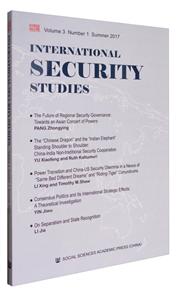2017-INTERNATIONAL SECURITY STUDIES-国际安全研究-第1辑
节选
[
《国际安全研究(2017年第1辑 英文版)》: 1.1 The Historicallnexorability of China and India Joining Hands in the 21st Century The long history of interaction and integration of civilizations is a prerequisite for the establishment of a “brother-like” inter-State relationship. The advantages for China-India cooperation is that the two “great civilizations” progress with their cultural heritage and interact and integrate with each other for their mutual development. In global politics, it is believed that one element is indispensable to the inexorability and possibility of cooperation between two countries, namely the inheritance and integration of “civilization.” As ancient, several-thousands-of-years-old civilizations, both China and India have survived and evolved till today by “responding to challenges”(Toynbee). The story is well-known in China that Monk Xuanzang(玄奘) of Tang Dynasty made a pilgrimage to India. Besides, India’s modernization and democracy process started earlier than China’s. Consequently, some people think that India can be the “elder brother” in the “brother-like” relationship. Some scholars believe that the features of material culture shared by China and India and the “great power complex” result in a competitive relationship just as “two rival tigers cannot exist in the same mountain.” Still, some other researchers scrutinize the argument about whether China and India “complement” or “compete” with each other. These analyses often overlook the China-India “brother-like” relationship. It is universally acknowledged that ancient China led the world in technological and scientific development with four great inventions: compass, gunpowder, paper-making technology and printing. Modern China excels in infrastructure development, accomplished large-scale industrialization and has implemented highly effective policies to combat climate change and also to overcome poverty. Since its reform and opening-up, China has become “the world’s factory.” All these efforts have attracted worldwide attention to China. India is the birthplace of Buddhism and Hinduism with rich ideological legacy and splendid scientific achievements, leader in ancient mathematics and astronomy and inventor of the number zero. It is a liberal democratic country with a strong tradition of entrepreneurship. Modern India’s industry of new and high technology is very advanced. In addition, India leads the world in software technology and has been “the back office of the world.” Historically, Chinese civilization has been characterized by “golden mean and inclusiveness” and Indian civilization by “benevolence and non-violence” and the two countries have been friendly neighbors and learned from and integrated with each other. Indian Sinologist B. R. Deepak points out that numerous Chinese and Indian messengers ofculture, such as Faxian(法显), Kumarajiva(鸠摩罗什), Bodhidharma(菩提达摩), Xuanzang and Yijing(义净) made journeys freely to each other’s country including scholarly engagement and translation of Buddhist teachings based at Nalanda monastery(BCE 7-1200 CE). Indian dance, astronomy, calendar, literature, architecture and sugar-making techniques were introduced to China while Chinese paper-making, silk, porcelain, tea and music were spread to India. All these bear witness to a long-standing history of cooperation, exchanges and mutual learning and sharing knowledge between t e two peoples. The cooperation between countries in a “brother-like” relationship requires each country to have an aspiration for national renewal to be a strong power. China-India cooperation is necessitated by the two largest developing countries’ dream of “national renewal” and joint pursuit of becoming world powers. For “national revitalization, ” China and India proposed the “Chinese Dream” of being a responsible power and the “Indian Dream” of becoming a world power respectively. In recent years, with the deepening of economic globalization, cooperation between China and the West in manufacturing and trade has grown extensively. Globalization has enhanced the cooperation between all countries in the world and conforming to similar trends, China and India have become the largest developing countries and emerging markets in the world. In particular, China as the “world’s factory” and India as the “back office of the world” are highly complementary, China’s westward opening-up strategy is greatly aligned with India’s “Look East” policy and evidence suggests that the adroit integration of “Chinese energy” and “Indian wisdom” will unleash great potential. All these will create more opportunities for China and India, to surmount existing obstacles and to work together shoulder-to-shoulder and promote win-win partnerships. ……
]
内容简介
[
《国际安全研究(2017年第1辑 英文版)》是由国际关系学院主办的《国际安全研究》的对应英文集刊,主题是国际安全理论研究,内容涉及不干涉内政学说、世界体系的发展、历史视角中的三次世界大战、质性和平的条件比较(当代东亚与战后西欧)、当代国际安全的文化价值基础、互联网对国际政治影响机理、中国周边安全环境指标体系及其评估、联合阵线与美国军事干涉等问题的研究。
]
目录
Let’s Focus on Global Security GovernanceThe Future of Regional Security Governance: Towards anAsian Concert of PowersThe “Chinese Dragon” and the “Indian Elephant” Standing Shoulder toShoulder: China-India Non-traditional Security CooperationPower Transition and China-US Security Dilemma in a Nexus of “Same BedDifferent Dreams” and “Riding-Tiger” ConundrumsConsensus Politics and Its International Strategic Effects: A TheoreticalInvestigationOn Separatism and State RecognitionSecurity Concepts and Climate Change: ASEAN Perceptions and PoliciesOn the Evolution of the Arctic Route Geo-Security StructureNotice to Contributors
封面

书名:2017-INTERNATIONAL SECURITY STUDIES-国际安全研究-第1辑
作者:陶坚
页数:152
定价:¥89.0
出版社:社会科学文献出版社
出版日期:2017-06-01
ISBN:9787520109116
PDF电子书大小:37MB 高清扫描完整版
